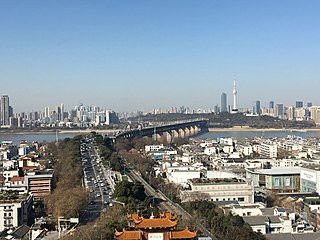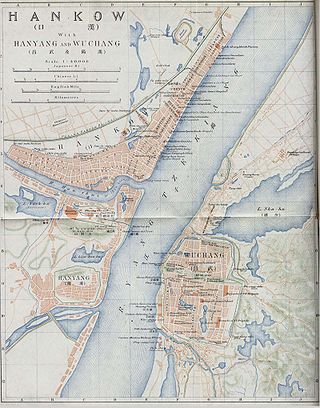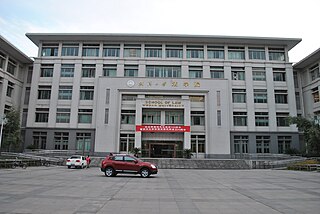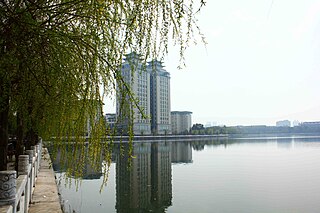Related Research Articles

Wuhan is the capital of Hubei Province in the People's Republic of China. It is the largest city in Hubei and the most populous city in Central China, with a population of over eleven million, the ninth-most populous Chinese city and one of the nine National Central Cities of China.

Wuchang forms part of the urban core of and is one of 13 urban districts of the prefecture-level city of Wuhan, the capital of Hubei Province, China. It is the oldest of the three cities that merged into modern-day Wuhan, and stood on the right (southeastern) bank of the Yangtze River, opposite the mouth of the Han River. The two other cities, Hanyang and Hankou, were on the left (northwestern) bank, separated from each other by the Han River.

Hanyang District forms part of the urban core of and is one of 13 urban districts of the prefecture-level city of Wuhan, the capital of Hubei Province, China. Currently, it is a district and stands between the Han River and the Yangtze River, where the former drains into the latter. It is connected by bridges with its former sister cities, Hankou and Wuchang. Presently, on the left bank of the Yangtze, it borders the districts of Qiaokou to the north across the Han River, Jianghan to the northeast, Caidian to the southwest, and Dongxihu to the northwest; on the opposite bank it borders Wuchang and Hongshan. Guiyuan Temple is located in Hanyang.

Wuhan University is a public research university in Wuhan, Hubei. The university is affiliated with and sponsored by the Ministry of Education of China.

Hankou, alternately romanized as Hankow, was one of the three towns merged to become modern-day Wuhan city, the capital of the Hubei province, China. It stands north of the Han and Yangtze Rivers where the Han flows into the Yangtze. Hankou is connected by bridges to its triplet sister towns Hanyang and Wuchang.

Jiangxia District is one of 13 urban districts of the prefecture-level city of Wuhan, the capital of Hubei province, China, situated on the eastern (right) bank of the Yangtze River. Jiangxia district has an area of 2,009 square kilometres (776 sq mi) and a population of 680,000. It is the southernmost and most sparsely populated of Wuhan's districts. It borders the districts of Caidian and Hannan across the Yangtze and Hongshan to the north, as well as the prefecture-level cities of Ezhou to the east, Huangshi to the southeast, and Xianning to the south.
Wuhan Sports University, formerly translated as Wuhan Institute of Physical Education, (WIPE), is a tertiary educational institution in China. According to the statistics released by the Ministry of Education of China, the university is one of the four leading universities in the physical education area in China. The university has many world-famous alumni, such as gymnast Cheng Fei, who won more than 19 gold medals including an Olympic one. And this can be better illustrated during Beijing 2008 Olympic Games, when WIPE alumni alone won 6 gold medals, 2 silver medals and 3 bronze medals.

Hankou railway station is one of the three main railway stations in the city of Wuhan, the capital of Hubei Province of the People's Republic of China. It is located within the section of the city commonly known as Hankou, several kilometers north of Hankou's historical center. Hankou Station is served by a station of the same name on Line 2 of Wuhan Metro.
Hanchuan railway station is a railway station located in Hanchuan, Xiaogan, Hubei Province, People's Republic of China, on the Wuhan–Yichang railway, operated by China Railway Wuhan Group. It is located approximately 15 kilometres (9.3 mi) away from the city centre. It opened on 1 July 2012.
The Hankou–Danjiangkou railway or Handan railway, is a railroad in central China between Wuhan and Danjiangkou in Hubei Province. The line is 411 km (255 mi) long and follows the Han River from Wuhan's Hankou District north to Danjiangkou near the border with Henan Province. The line was built from 1958 to 1966 and double-tracked in 2009. Major cities and towns along route include Wuhan, Anlu, Suizhou, Zaoyang, Xiangyang, Laohekou and Danjiangkou.

The Line 1 of Wuhan Metro is an elevated metro line in the city of Wuhan, Hubei. It is the longest continuous metro viaduct in the world. Line 1 opened on 28 July 2004, making Wuhan the fifth city in mainland China to have a metro system after Beijing, Tianjin, Shanghai and Guangzhou. This is the first Metro line in China incorrectly referred to as a light rail line in Chinese terminology because it is elevated. Originally a branch line was planned to cross the Yangtze to Wuchang District via the Second Wuhan Yangtze River Bridge. The Second Wuhan River Bridge even had a provision in the central median where Line 1 trains would run in anticipation for the branch line when it opened in 1995. However, by 2003 the reservation was removed to allow for more traffic lanes when the bridge was undergoing renovation.

Wuhan University School of Law is the law school of Wuhan University in Wuhan, China. The School of Law was oft-referred as one of the "Four Famous Law Schools" in China, and one of the "four departments and five colleges," representing the highest level of legal education in China. According to a 2009 evaluation conducted by the Chinese Ministry of Education, Wuhan Law was ranked the 3rd among the law schools in China, tied with Peking University. Both its undergraduate and graduate programs are ranked the 3rd in China by Wu Shulian.

Wuhan Qingchuan University is a private college created by a joint venture between several private companies and Wuhan University in 2006. The school is in Jiangxia District, Wuhan, China. The school offers education in electrical engineering, information technology, humanities, and foreign languages. The school was renamed to its current name from "Luojia College" in 2016.
The Port of Wuhan is the natural river port of the sub-provincial city of Wuhan, Hubei Province, People's Republic of China. The port lies at the confluence of the Yangtze and Hanjiang rivers. It is able to handle ocean-going ships of 10,000DWT. In 2013, it had a throughput of 42.2 million tons of cargo, and 513,229 TEU of containers.

Wuhan University School of Chinese Classics is a school in Wuhan University that teaches Chinese classics, a joint collaboration between Wuhan's Schools of Chinese, History, and Philosophy. The school awards undergraduate, master, and doctoral degrees, one of the few in China to offer a comprehensive education in Chinese classics. Japanese is a mandatory second language in the school.
Trams in Wuhan may refer to any one of the tram systems currently operational in the city of Wuhan, Hubei, China. The first tram started revenue service in Wuhan is the Auto-city T1 Line, which began on July 28, 2017. Subsequently, Optics Valley tram started revenue service from April 1, 2018.

Tangxun Lake, formerly Tangsun Lake, is a freshwater lake between Hongshan District and Jiangxia District in southeastern Wuhan, the capital of Hubei Province, China. It is south of Wuhan's Third Ring Road and north of its Fourth Ring Road. Tangxun Lake is the largest lake completely enclosed by a city in Asia.

Guanshan Subdistrict is a subdistrict in Hongshan District, Wuhan, Hubei, China. To the east it borders the Donghu New Technology Development Zone; to the south it borders Jiangxia District and the Third Ring Road; to the west it borders Zhuodaoquan Subdistrict ; to the north it borders the East Lake Nature Scenic Area. The subdistrict encompasses the campuses of more than ten universities including Huazhong University of Science and Technology, China University of Geosciences, South Central University for Nationalities, Zhongnan University of Economics and Law, and Wuhan Textile University (武汉纺织大学).

Fangcang hospital refers to a kind of makeshift/mobile field hospitals used during the COVID-19 pandemic in China.
References
- ↑ "Hankou University". Archived from the original on 2012-04-18. Retrieved 2012-03-25.
- ↑ "汉口学院简介". Archived from the original on 2012-03-06. Retrieved 2012-03-25.
- ↑ "汉口学院称将用8年升格为"大学"". 长江商报. Archived from the original on 2014-02-22. Retrieved 2012-03-27.